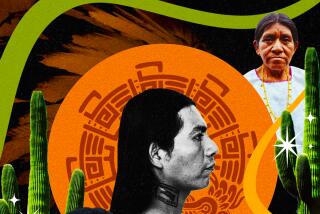Modern challenges greet oral historians meeting in Little Tokyo
- Share via
The first to speak, Karen Harper, came right out and admitted it:
“I still use cassette tapes.”
The second:
“I have tapes that are 20 years old that still need to be digitized.”
The third:
“I just bought my first digital recorder six months ago.”
As oral historians gathered to kick off the Southwest Oral History Assn.’s Conference in Little Tokyo, the story-keepers, one by one, came clean: They needed help entering the modern age.
Oral history is an ancient tradition of capturing and passing on life stories and experiences. But many of the collected words of genocide survivors, civil rights activists, war veterans and ordinary people with extraordinary pasts have yet to find their way to broad audiences.
Most recorded voices are still stored in obscure collections in universities and museums or in historians’ home offices. Thousands of hours are on cassette or reel-to-reel tape, vulnerable to deterioration and not backed up. Some have not been listened to in decades.
Lack of training is one reason. Money is another. Transferring decades of audio into digital files is costly. Ethics also comes into play. What would people interviewed in the 1950s have said about posting their personal stories on the Internet for all the world to hear?
At the four-day 30th anniversary conference, which ends Sunday, panels and workshops looked toward the future.
Like many, Harper, an independent historian from Long Beach, showed up at the daylong audio training class intimidated but eager to learn.
She and 10 other historians from as far away as Oklahoma watched as Susan Kitchens demonstrated how to edit a digitally recorded oral history, then upload it onto the Web.
New vocabulary — label tracks, wave files — flew around the room. It took some a while to absorb.
“All I knew before was to hit play and record,” said Harper, who is working on an oral history of airline flight attendants after Sept. 11.
Once she catches up to technology, however, she’s not sure about putting her recordings online. It makes a lot of oral historians nervous.
Most have the freedom to share as they please because interviewees sign over the rights to their comments. But they take their responsibility as stewards of the stories very seriously.
Horacio Roque Ramirez, president elect of the national Oral History Assn., spent a stretch of the 1990s interviewing gay people in San Francisco. Many of those he recorded struggled to open up.
Transcripts of their stories are available at libraries in the Bay Area, but Ramirez keeps the recordings at home, safe from people he worries might want to manipulate or misuse the audio to disrespect gay people.
“I’m very leery about these things,” he said, “because I know how they can be used.”
Ali Igmen, an assistant professor of history at Cal State Long Beach, has a different view.
Igmen runs his school’s oral history program, which has many complete recordings on its website. Listeners from around the world — New Zealand, Peru, Chile — visit daily to hear the accounts of American Indians, Southeast Asian refugees and early 20th century suffragists.
Making them any less public, or available only in academic circles, would be like censoring them, Igmen said.
“If you don’t let everyone hear these stories, either secret or painful, then you’re just letting them die with these people,” he said. “And that’s unethical.”
Still, as open as Igmen is about access, he’s squeamish about some suggested innovations in his field.
For decades, oral histories have been recorded voices, pure and simple. But there is some pressure now to use video.
Igmen thinks it could harm the process.
“People either tend to be really shy about being on camera or they tend to perform,” he said. At Columbia University, oral historians were among the first to begin using video. Their interviews range from traditional one-one-one audio in people’s homes to small video productions in a studio, complete with a sound crew and lights.
The person being interviewed is given the choice, said Mary Marshall Clark, director of Columbia’s Oral History Research Office.
“It would be condescending of us to assume that someone might not be comfortable with video,” she said. “It’s impossible to predict. Those you think would be most reluctant are often the most open.”
esmeralda.bermudez@latimes.com
More to Read
Sign up for Essential California
The most important California stories and recommendations in your inbox every morning.
You may occasionally receive promotional content from the Los Angeles Times.











